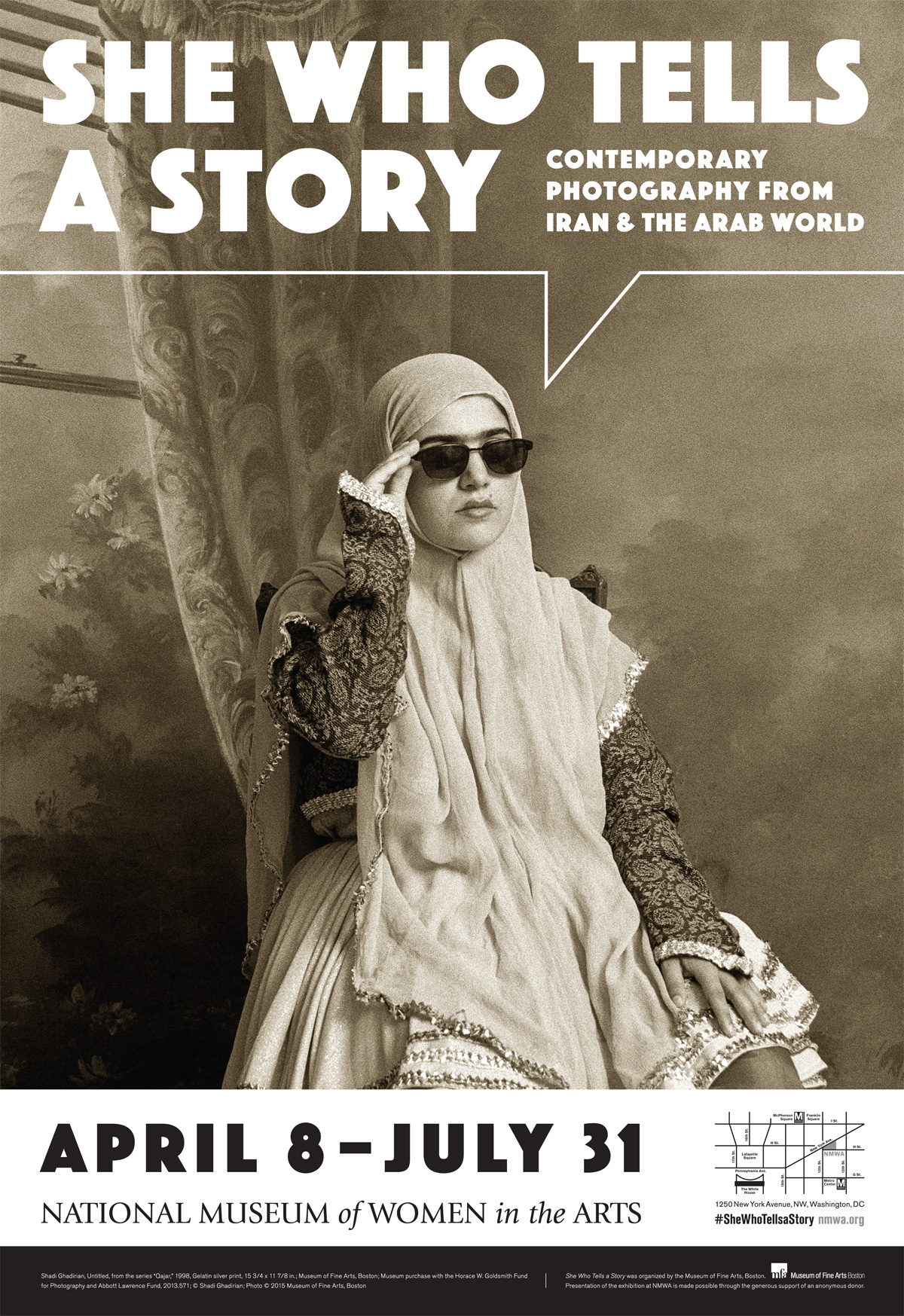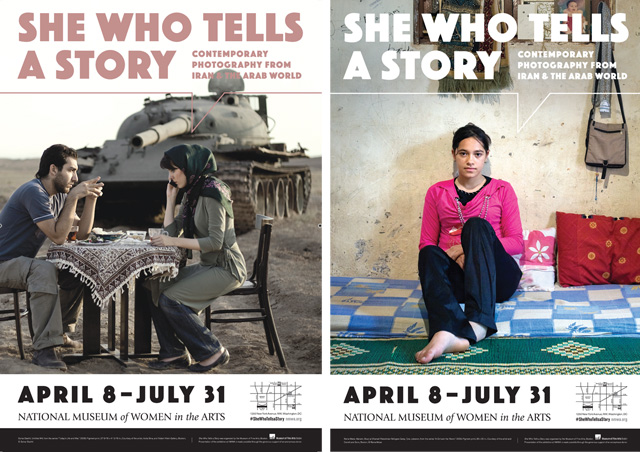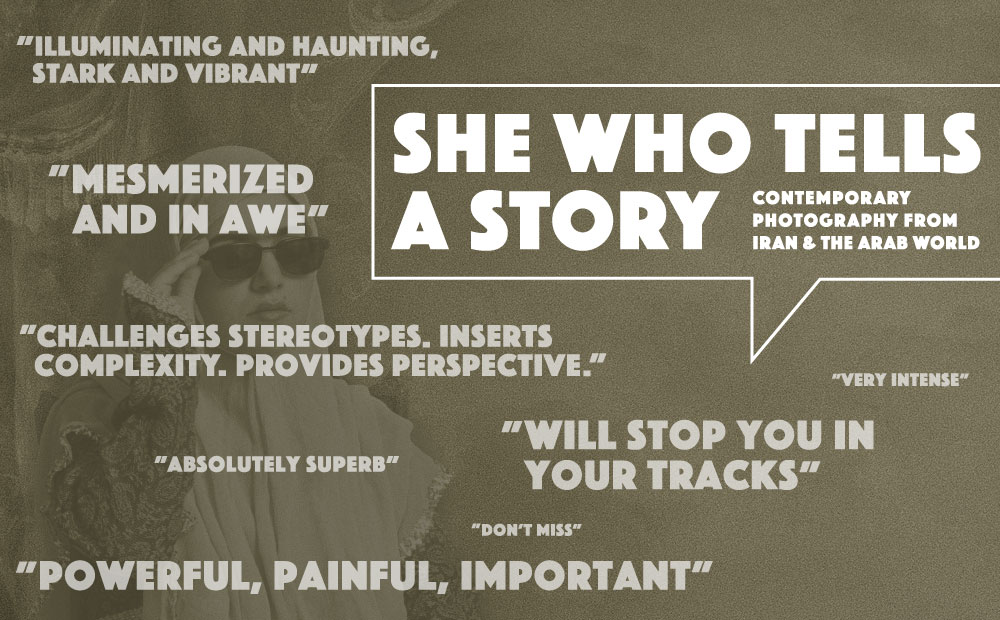More than a year ago, we successfully advertised an exhibition for the National Museum of Women in the Arts in Washington, D.C. called Picturing Mary: Woman, Mother, Idea. The advertising campaign was based on the headline “Meet Mary,” and it was targeted at a persona we identified as the primary marketing target. She was Lila the “Catholic pilgrim.”
“Lilas” came in droves.
Picturing Mary was one of the most well-attended exhibitions in the museum’s history (242% of the average daily attendance between 2004-15). During the first three weeks of the current exhibition, She Who Tells a Story: Women Photographers from Iran and the Arab World, we have experienced about 72% of the attendance of Picturing Mary despite using roughly half of the marketing dollars.

She Who Tells a Story
While the popularity of She Who Tells a Story is undoubtedly affected by the curiosity and national climate of oversimplification and stereotyping that surrounds the Arab world and Iran, the real engine for attendance is the quality of the exhibition itself. (Also, we’re proud of our advertising campaign.)
One attendee described it as “transformative,” and that’s not really an overstatement.
She Who Tells a Story provides something I rarely get in any museum but always crave—an experience that is rich and emotionally powerful while also genuinely enlightening. How often does an exhibition challenge you both intellectually and emotionally and change the way you look at the world? This is the cumulative effect of She Who Tells a Story.
The exhibition represents an array of deeply personal perspectives on everything from the challenges of being a teenage girl to the question of how anyone can document the emotional impact of living in a war zone and even the question of what is portraiture in a cultural environment that routinely obscures women’s hair and faces.
This exhibition does an amazing job of opening a window into a world populated by women whose perspectives are rarely given much thought in the United States. This window is now open just steps from the White House and will remain so through July 31st. I hope it inspires a reevaluation of our simplified assumptions about women in the Arab and Iranian world. Its cultural relevance is undoubtedly timely in this particular political season.
If you do get the opportunity to see She Who Tells a Story, make a point of listening to the audio. The curators have collected some of the artists’ thoughts and the effect is truly powerful.
Champion women through the arts
The central tenet of the National Museum of Women in the Arts’ updated brand strategy is to “champion women through the arts.” She Who Tells a Story, while originally organized by the Museum of Fine Arts in Boston, is not only looking like a significant public success for the women’s museum, but is also a concrete illustration of the organization’s core values and mission. It is both proof that a new audience exists for the museum and another example of the museum’s healthy transition into contemporary relevance.
Evidence that this strategy is having the desired brand impact can be seen in the first line of the Washington City Paper’s Best of D.C. 2016 pick:
“It’s been dazzling to watch the transformation of the National Museum of Women in the Arts.”
—Kriston Capps
She Who Tells a Story, along with the upcoming special exhibition No Man’s Land: Women Artists from the Rubell Family Collection slated to open in late September and innovative new programming like the Women, Arts, and Social Change initiative that launched last fall, is putting the National Museum of Women in the Arts back on the arts map of Washington D.C. It is living up to its mission and we are excited that it is actively gaining a reputation as a destination for art and ideas.
 She Who Tells a Story: Women Photographers from Iran and the Arab World runs through July 31 at the National Museum of Women in the Arts, 1250 New York Ave NW, Washington, D.C. 20005. 202-783-5000. More information at the National Museum of Women in the Arts website.
She Who Tells a Story: Women Photographers from Iran and the Arab World runs through July 31 at the National Museum of Women in the Arts, 1250 New York Ave NW, Washington, D.C. 20005. 202-783-5000. More information at the National Museum of Women in the Arts website.
July 13th Update
 She Who Tells a Story has held up throughout its run. Today the museum distributed a selection of quotes they collected from the press and visitors:
She Who Tells a Story has held up throughout its run. Today the museum distributed a selection of quotes they collected from the press and visitors:
It’s a must-see photography exhibition. Powerful and moving. #FeminismMatters.—Museum visitor
#SheWhoTellsAStory was breathtaking. Planning to see it again before it leaves!—Museum visitor
Feeling empowered by reading the stories from #SheWhoTellsAStory exhibit.—Museum visitor
…exceptional show, which touches on politics, gender, sexuality, cultural identity and critical issues of war, colonialism and oppression.—The Washington Post
She Who Tells a Story offers a masterclass on how to provide a platform for marginalized voices.—Hyperallergic
…shares the surprising, touching, and often untold stories of women in the Middle East.—Capitol File
Does your museum need an affordable way to improve its brand today?
Because we know that not everyone needs or can afford our full process, we created a guided tutorial package for our foundational brand strategy tool: the Brand Pyramid. Watch the video for a preview.
For more information on this brand strategy tutorial, visit here where you will find a fuller explanation and link to a free download of the first video.



Ask for help.
We are kind, thorough and ready when you are. You just need to ask.